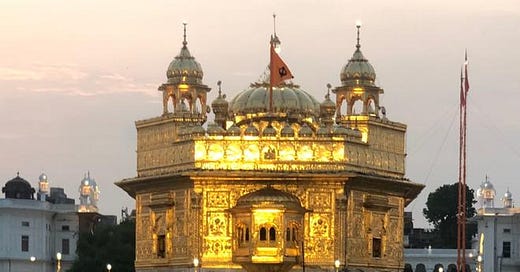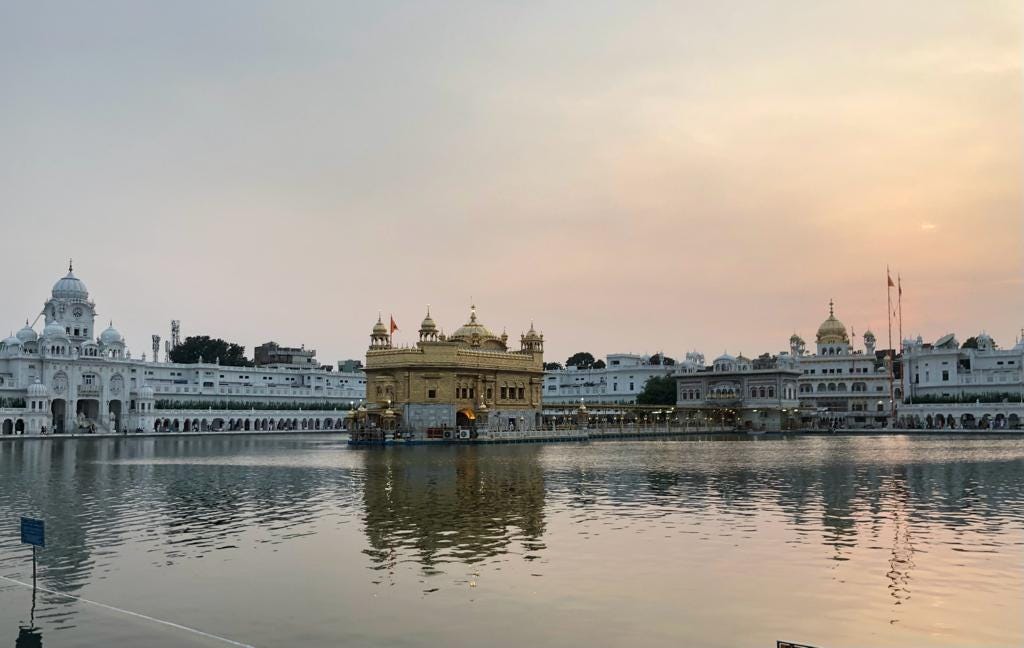The Indomitable Sikh Spirit and Mohandas Karamchand Gandhi
Sri Guru Gobind Singh, Gurmukhi, and the Boundaries of Reverence for Mahatma Gandhi.
About the Author
KBS Sidhu is a retired Indian Administrative Service (IAS) officer of the Punjab cadre and former Special Chief Secretary to the Government of Punjab. With over four decades of public service, he is a lifelong student of Sikh history and scriptures. In his post-retirement years, he is dedicated to reassessing historical narratives and critically examining iconic national figures through the lens of faith, constitutionalism, and cultural distinctiveness.
The Sikh Spirit and Mohandas K. Gandhi:
India’s public memory honours many towering figures whose legacies are often treated as beyond reproach. Mohandas Karamchand Gandhi is foremost among them; generations have admired his relentless moral discipline and the political earthquake he stirred through non-violent resistance. Yet Sikhs—whose history fuses spirituality with righteous moral force—have long felt that some of Gandhi’s views sat uneasily beside the timeless Khalsa tradition. This essay, written from an unapologetically pro-Sikh standpoint, offers a respectful but candid appraisal of an extraordinary mortal whose ideals occasionally clashed with Sikh experience.
Gandhi’s Judgment and the Limits of Non-Violence
In a 1925 issue of Young India, Mohandas K. Gandhi observed that had he lived in the age of Shivaji, Maharana Pratap, or Guru Gobind Singh, he might have regarded them as “misguided patriots.” This assessment, which may not be inconsistent with his lifelong commitment to ahimsā, reflected a particular absolutism—any recourse to the sword, however principled or defensive, lay outside his moral framework. From the Sikh perspective, however, Guru Gobind Singh embodied the saint-soldier ideal: an evolved articulation of the miri-piri doctrine first enunciated by Guru Hargobind Sahib, the sixth Guru. This dual vision of temporal and spiritual sovereignty affirms that the sword becomes necessary when dialogue, persuasion, and peaceful negotiation are exhausted.
Sikh Experience and the Role of the Sword
For the Sikhs, this principle was not philosophical abstraction but lived reality. Flowering from the teachings of Guru Nanak and culminating in the creation of the Khalsa by Guru Gobind Singh in 1699, the Sikh community endured centuries of persecution—from the Mughal state to foreign invaders like Nadir Shah and Ahmad Shah Abdali. The martyrdoms of Guru Arjan Dev Ji and Guru Tegh Bahadur Ji, and the unparalleled sacrifices of the four Sahibzadas, are not mere historical episodes but spiritual milestones. In this context, the kirpan—recognised under Article 25 of the Indian Constitution as an essential religious symbol—is not a weapon of aggression but an emblem of self-reliance, spiritual sovereignty, and resistance to tyranny. It embodies a moral imperative to stand against injustice, one that cannot be confined by rigid interpretations of non-violence possibly influenced by Jain metaphysics rather than the plural and often embattled histories of India’s borderlands.
Dr Ganda Singh’s Scholarly Riposte
Sikh historian Dr Ganda Singh, then head of the Sikh History Research Department at Khalsa College, Amritsar, publicly urged Gandhi to study the Guru’s life more closely before passing such judgment. At a 1947 gathering of the All-India Sikh Students’ Federation, Gandhi—moved by the historian’s erudition—acknowledged his limited understanding and expressed regret. Dr Ganda Singh’s intervention stands as a reminder that respectful, scholarship-based critique can refine even the convictions of a national icon.
The Script Debate: Gurmukhi as Sacred Identity
Gandhi believed that adopting a common script—Devanagari—for all major Indian languages would serve national cohesion. For the Sikh community, however, this proposal was fundamentally unacceptable. Gurmukhi is not merely a utilitarian script; it is a sacred medium, standardised by Guru Angad Dev Ji, the second Nanak, at Khadoor Sahib, to democratise access to spiritual knowledge and liberate Gurbani from the monopoly of traditional priestly classes. Through Gurmukhi, the word of the Gurus became the shared inheritance of the entire sangat.
To render Punjabi in Devanagari or the Persian-derived Shahmukhi would risk dissolving the distinct visual and spiritual identity of the verses enshrined in the eternal Sri Guru Granth Sahib. Such a change could blur the Sikh scriptural tradition into larger Hindu or Islamic literary spheres—undermining the unique theological and civilisational space that the Gurus had so consciously cultivated. Gurmukhi is thus not a regional preference, but a foundational pillar of Sikh sovereignty and collective psyche and memory.
Gurmukhi as a Cultural Charter
The very term “Gurmukhi”—meaning “from the mouth of the Guru”—proclaims revelation in script. Its strokes carry the cadence of kirtan; its visual rhythm demarcates a cultural and spiritual frontier. Gandhi’s single-script idea, however well-intentioned, underestimated the strength of diversity in reinforcing, rather than weakening, the unity of a pluralistic society.
Reconciling Two Visions of Freedom
Gandhi ji never claimed to be infallible; his collected writings frequently use the language of “experiments,” revealing a spirit in continuous moral inquiry. Yet his sweeping dismissal of armed resistance and advocacy for script uniformity reflected the constraints of a worldview shaped in courtrooms and ashrams—arenas of civil discourse—rather than on frontier battlegrounds where justice was often claimed through courage and sacrifice.
Guru Gobind Singh taught that when every legitimate avenue of redress—dialogue, persuasion, and peaceful appeal—has failed, the sword may be unsheathed to protect the downtrodden. This is no romantic anachronism; it is a living principle, preserved in both the sound and script of Gurmukhi. For Sikhs, the right to righteous resistance and the sanctity of their script are not sectarian choices but expressions of universal liberty and enduring human rights.
Dharma Yudh: From Kurukshetra to Anandpur Sahib
The Sikh worldview, as shaped by the Gurus and crystallised in the Khalsa, does not romanticise violence—it sanctifies righteous resistance. This principle finds precedent in an older Indian canon: the Bhagavad Gita, where Lord Krishna exhorts Arjuna to rise in arms not out of desire or vengeance, but in the service of dharma. “धर्म्याद्धि युद्धाच्छ्रेयोऽन्यत्क्षत्रियस्य न विद्यते”—“For a Kshatriya, there is nothing more honourable than a war fought in the cause of righteousness” (Gita 2.31).
Guru Gobind Singh gave voice to this same ethos in his Persian epistle Zafarnama to Emperor Aurangzeb, where he declared with piercing clarity:
"Chun kar az hameh heelate dar guzasht, halal ast burdan ba shamsheer dast."
(“When all peaceful means are exhausted, it is righteous to draw the sword.”)
These words reflect not defiance alone but moral necessity—a dharma yudh against tyranny. They resonate with Krishna’s instruction at Kurukshetra and reaffirm that the Sikh tradition is not outside the Indian civilisational arc but firmly rooted in its deepest ethical soil. Gandhi’s absolutist ahimsa, while noble in intent, diverged from this broader moral logic that values justice—even if secured through just force—over passivity in the face of evil.
A Balanced Verdict on an Extraordinary Mortal
Gandhi inspired millions, delegitimised colonial power, and embodied personal austerity with uncommon resolve. Yet he, too, had his blind spots. His moral absolutism occasionally overlooked the distinct historical and cultural experiences of others—especially the Sikhs. To acknowledge this is not to deny his greatness; it is to restore proportion. To refer to him as “Mahatma” in the exalted sense reserved for the Buddha may be excessive. To regard him as an extraordinary mortal of luminous moral conviction is tribute enough.
Guru Gobind Singh: The Eternal Father of the Khalsa
For every Sikh, Guru Gobind Singh Ji is not simply a spiritual exemplar—he is the eternal Father of the Khalsa. It was through his divine vision and sovereign command that the Khalsa was born on the Vaisakhi of 1699, forging a community of saint-soldiers bound by discipline, devotion, and fearlessness. His legacy endures in every amritdhari Sikh who upholds his hukam—not as ritual alone, but as a living code of identity. His fatherhood is not symbolic—it is sacred, lived, and reaffirmed daily in prayer, practice, and shared memory.
Unlike popular titles conferred by mass sentiment, Guru Gobind Singh’s role as pitā of the Khalsa is woven into the very fabric of Sikh consciousness. He did not merely inspire a movement—he constituted a sovereign spiritual nation rooted in equality, dignity, and divine justice.
Gandhiji and the Idea of “Father of the Nation”
In contrast, the designation of Gandhi as “Father of the Nation,” though widely used and affectionately embraced, has no legal or constitutional sanction. Multiple Right to Information (RTI) queries and government responses—from the National Archives to the Ministry of Home Affairs—have confirmed that no ordinance, notification, or official declaration ever conferred that title upon him. Article 18(1) of the Indian Constitution, which prohibits the State from conferring titles except military and academic ones, prevents any such official recognition.
The phrase originated in a 1944 radio broadcast by Subhas Chandra Bose and gained popular traction, echoed later by Sarojini Naidu. While the Supreme Court has acknowledged Gandhi’s moral stature as towering beyond state honours like the Bharat Ratna, it also noted that such reverence arises from the collective heart of the nation—not from a formal decree.
Reconciling Memory and Meaning
In reconciling these parallel narratives, we must distinguish between devotional truth and popular attribution. Guru Gobind Singh Ji’s fatherhood of the Khalsa is not a matter of folklore—it is embedded in doctrine, ceremony, and scriptural authority. Gandhiji’s designation as “Father of the Nation” is a powerful metaphor born of admiration and historic gratitude, but it remains a symbolic gesture without official foundation.
Nations flourish when they honour their heroes with honesty and clarity—when reverence is grounded in truth, and when every community has the dignity to preserve and proclaim its own legacy. For Sikhs, Guru Gobind Singh Ji stands far above the realm of temporal leadership. He is not to be compared with any mortal figure, however revered. As the eternal Father of the Khalsa, his legacy is divine, sovereign, and timeless—etched in Gurmukhi, enshrined in the Guru Granth Sahib, and lived through the Khalsa Panth. It requires no validation from the modern-day State, no popular appellation, and no borrowed title. Its permanence rests not in official proclamations, but in the unwavering faith of generations who continue to walk the path he revealed—with courage, dignity, and unshakeable conviction.
Birth of Gurmukhi: How it Survived the Mughals, the Monarchy, and the Mahatma
Birth of Gurmukhi: Introduction






Gurmukhi: Starting from the first word, I could not stop accompanying you to the depths of the last word. Thank you for sharing your in-depth ideas.
Having come up from a khalsa institution, I fail to understand why the khalsa schools, khalsa colleges, per say khalsa institutions could not grow as light houses of learning in comparison to national and global areas of learning. Consequently sikh masses in general have been miserably left behind.
Yes, it is too late to understand reasons, but framing of remedies has to start somewhere.
Bhupinder Singh Mann
It is a shame that we do not have sikh missionaries here in South India. Do we even have regional translations of the Guru Granth Sahib